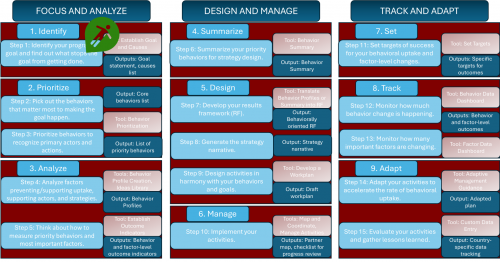Your goal is at the foundation of your program as it tells you where you want to be at the end of your program. Goals can be long-term and country-wide, such as:
- Reduce infant mortality by one-third from the [year] level in my country in the next five years.
- Catalyze my country’s long-term development strategy, offering a productive, healthy life to all its citizens by [year].
- By [year], catalyze transformation of a holistic health system to sustain equitable improvements in health for all citizens of my country.
Or goals can be focused on a more immediate, short-term, topic-specific result, like:
- Increase the uptake of COVID-19 vaccines over the next 18 months.
- Improve overall hygiene standards of hospital pediatric wards in one year.
- In our area, strengthen outreach voter systems over two years.
Whether your goal is long-term or short-term, country-wide or area or topic-specific, depends on your particular program.
Sometimes your goal is predefined. If so, great! Half the work is already done. But if you haven’t set your goal yet, here are some questions to get you started:
- What are the most pressing challenges, as it relates to your topic, facing your country/area in the next 1-2 or 5-10 years?
- What change or progress do you hope to see in 1-2 or 5-10 years?
- What can or should your program do to contribute to that change?
“Causes” are the negative issues interfering with you achieving your goal. Causes can be broad and encompassing, like lack of transparency and accountability, limited funding, and inadequate capacity to manage funds. Or they can be more specific, such as weak health system information data use, insufficient donor support for gender issues, and poor accounting systems hardware and software.
No matter if causes are broad or specific, they limit your ability to achieve your goal. By identifying these causes and setting out behaviors that can overcome them (Step 2), you focus on the behavioral outcomes (the change driving your program) with the most potential to achieve your goal.
Evidence is essential to determining these causes. There is a lot of existing data you can use as a starting point. It’s usually not necessary to conduct research to gather more.
Need some help finding existing data? Check out our detailed country data by health topic or by country on select health behaviors.
Can’t find what you are looking for there? Try the Demographic Health Survey (DHS).
Otherwise, look for data from relevant:
- national data sources,
- donor internal assessments,
- Global Health Data Exchanges,
- Global Burden of Disease Studies,
- World Development Indicators,
- World Bank DataBank,
- Living Standards Measurement Studies,
- Integrated Surveys,
- Human Development Reports,
- World Governance Indicators,
or other context-specific reports and papers (both published and unpublished).




 The Manoff Group was acquired by JSI in 2022.
The Manoff Group was acquired by JSI in 2022.